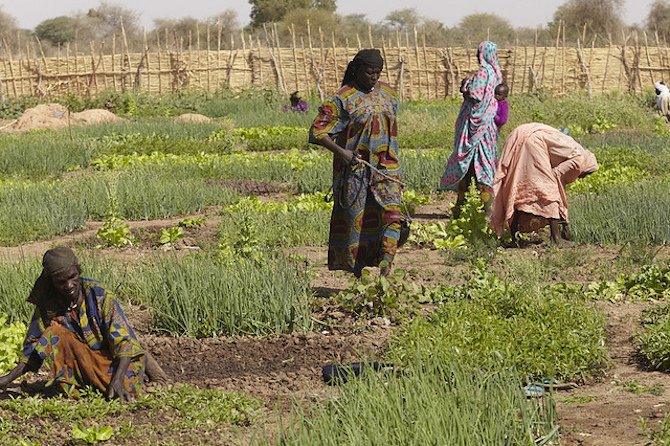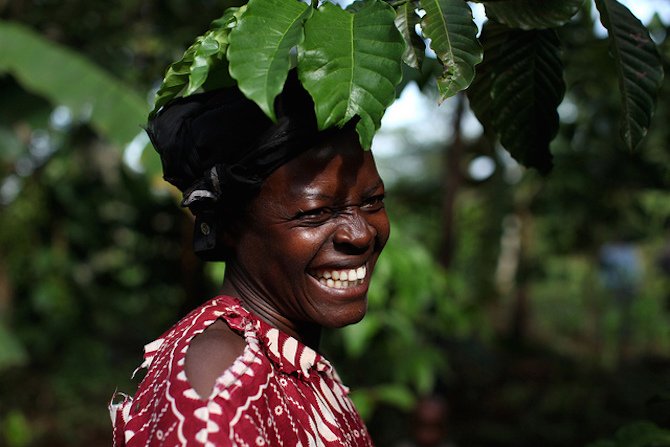I don’t know about you, but I spent much of my childhood thinking that the farmers of the world looked like Old MacDonald. My idea of a typical farmer involved a man dressed in plaid and a straw hat with a little piece of wheat between his teeth, whistling and waving from atop his shiny green tractor. Although the image was amended as I got older - imaginary Farmer Joe no longer had to be gnawing on raw wheat - I pretty much exclusively associated farming with men.
By taking action on Global Citizen, you will have a chance to win tickets to this year's Global Citizen Festival in New York City on Sept. 24, 2016. Learn more about the Global Citizen Festival here.
It wasn’t until I left the US for the first time to visit a family friend in India and saw women along the streets carrying massive bags of cow dung fertilizer and crop seeds that I realized: Women are farmers too.

In fact, agriculture is not at all a guys-only game. Women comprise 43% of the world’s agricultural labor force, a statistic that rises to over 50% in Sub-Saharan Africa and Eastern Asia. In over 30 countries, women constitute the majority of agricultural laborers. These female farmers, however, are not treated the same as their male counterparts. Despite the important role they play in agriculture, women in developing countries face more extreme poverty, less education, and lower literacy rates than men. They do not have access to or control over land and productive resources.
Why is it that men and women farmers are equally represented in agriculture, but don’t also enjoy equal economic benefits?
Barriers that female farmers face that men don’t
Time constraints and competing priorities:
In many developing countries, social norms obligate women to be responsible for far more than maintaining the family farm. In addition to tending the crops, they are also expected to cook, carry water, fetch firewood, and take care of the family. Taking into account both paid productive work and unpaid domestic responsibilities, rural women’s total work hours are considerably longer than men’s. Because of this, female farmers rarely have a say in important financial decisions and are unable to access useful resources. Who has time to learn about new fertilizer varieties when you have 6 children, a water source that’s 2 miles away, and dinner to cook?

Access to productive resources:
The vast majority of studies have found that differences in crop yields between men and women exist not because women are less skilled in farming, but because they have less access to resources such as as improved seeds, fertilizers and equipment. A study on an irrigated rice project in Gambia found that less than 1% of women owned a seeder, weeder or multipurpose cultivation instrument, compared to 27%, 12% and 18%, respectively, for men. That would be like trying to keep up with the kid on the motorized bike when all you have to ride is a tricycle.
Land ownership:
The graphic below is from Farming First, and shows the discrepancy in land ownership between men and women in developing regions.

The contrast is stark. Remember, in Sub-Saharan Africa women make up 50% of the agricultural labor force. Yet they own less than 20% of the agriculture plots. Even more alarmingly, women in Cameroon contribute more than 75% of agricultural labor yet own just 10% of land. When women are farming on land that belongs to another person, the profit earned most likely goes to the landowner, not the women. Moreover, where women do hold land, their plots are generally smaller, of lesser quality, and have less secure rights than those held by men.
Access to credit:
In most places, the number of women who have access to credit is 5-10% less than men. Without access to credit, women often cannot buy the resources essential to farming, such as seeds, tools and fertilizers, or invest in irrigation and land improvements.
Extension:
Despite how many female farmers there are, they tend to receive far less support from national and international development organizations than men do. The graphic below, also from Farming First, shows the lack of support female farmers enjoy compared to men.

What if the global community eliminated these barriers?
We would be on track to eliminate global hunger and poverty, that’s what!
Gender equality in agriculture is absolutely essential for sustainable development. Women farmers typically achieve yields that are 20-30% lower than men. However, substantial evidence suggests that women farmers can produce on par or better than men if granted access to the same resources. On average, women achieve higher values of output per hectare than men, on much smaller plots. The Food and Agriculture Organization of the United Nations (FAO) estimates that if women had the same access to productive resources as men, the total agricultural output in developing countries would increase by up to 4% and reduce the number of hungry people in the world by 12–17%. If that happened, it would affect up to 150 million people. Translation: Give women the right resources and 150 million fewer people go hungry.
 Jane Sebbi, a farmer in Kamuli, Uganda
Jane Sebbi, a farmer in Kamuli, Uganda
And if you’re still not convinced, take a look at how women invest their money. Girls and women spend 90% of their earned income on their families, while men re-invest only 30-40% on their families. If women are economically empowered through a gender-equal agricultural system, families and communities thrive.
Sounds pretty incredible to me.
So how can the global community create a world in which women farmers have equal access to resources? One way is to ensure that gender is a focal point in development initiatives. Another is to have service events at places and times that are convenient for women. Reforming laws and cultural barriers that block female access to credit and land ownership can also spur risk-taking and entrepreneurship.

But most importantly, the world must acknowledge the enormous role that women play in agriculture and the potential that they have to change the world if afforded access to the same resources as men. Gender equality, food security, and sustainable development are not independent of each other. In fact, not one of them can be achieved without the others. Equality for female farmers is not just about empowering women--it’s about ending hunger and poverty for everyone.